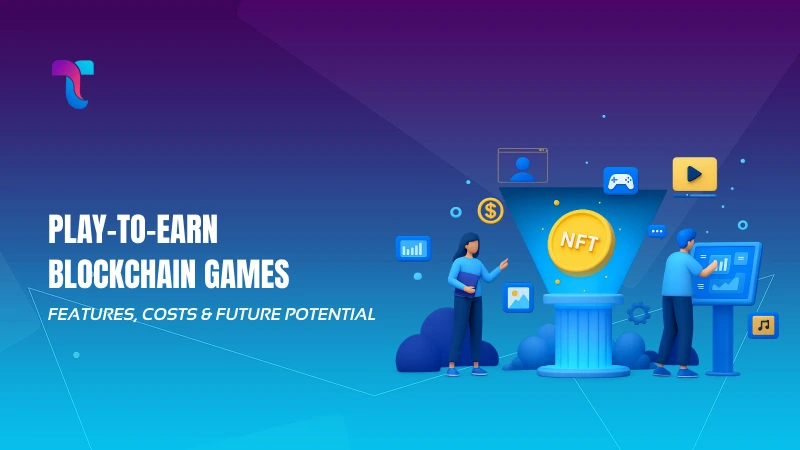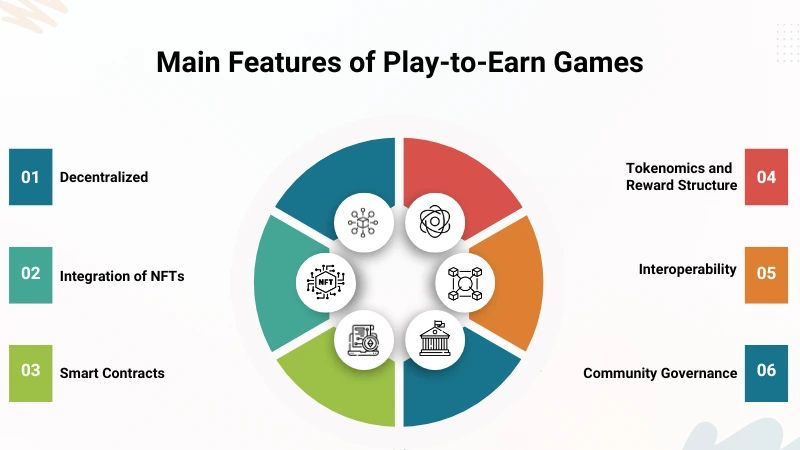What if every hour that you spent playing a game, you received a real-world reward? Imagine unlocking a character not just for bragging rights but as an actual income? This is exactly what play-to-earn Blockchain games promise. It is a fusion of traditional gaming and a chance to make money doing the same.
But the question is, how do these games work? What feature sets them apart from traditional games, and what does it cost to build one? And the most critical question we need to address is whether it is a passing trend or the future of gaming unfolding in front of our eyes.
In this blog, we are going to break down the key features, development cost, and long-term potential of play-to-earn games.
What are Play-to-Earn Blockchain Games?
At their very core, these P2E blockchain games are essentially just regular games that players can play and earn real-world value while doing so. Traditional video games are characterized by accomplishments and items that exist solely within the game ecosystem. However, P2E titles operate on the blockchain, which gives players real ownership of their in-game assets.
First, here are the major differences:
- In traditional games, the rare skin, sword, or pet you earned through perhaps weeks of grinding actually belongs to the game developers. Once the game closes, they basically disappear.
- In a P2E game, the equivalent items are often in the form of NFTs (non-fungible tokens), meaning that you actually own them. You can sell, trade, or even port them across platforms.
For many players, this eventually turns gaming from a pure hobby into an opportunity for earning tokens or cryptocurrency that can be converted into real money.
Some of the more potential examples for these games include:
- Axie Infinity – where you breed and battle NFT creatures, or Axies.
- The Sandbox – a metaverse world where users buy land, build experiences, and monetize them.
- Decentraland – a virtual world with tradeable assets, estates, and events driven by a community.
In short, P2E games are not just for fun, but they include playing for earning opportunity, which opens the door to new avenues of income and facilitates an alternative definition of what it means to be a “gamer.”
The Main Features of Play-to-Earn Games
One of the major selling points of play-to-earn games is their unique attributes. Each blockchain provides transparency, security, and actual ownership of digital assets. Let’s explore these features in depth:
Decentralized
There is no company or entity controlling everything in P2E games. This ensures the game’s fairness and transparency and allows shared ownership of the in-game economies since the game runs on a blockchain network.
Integration of NFTs
Characters, skins, weapons, and even virtual land are often converted into NFTs in the P2E space. This means they’re one-of-a-kind, which you can trade, and you actually own them instead of the game makers, like in traditional games.
Smart Contracts
Smart contracts are self-executing code that automatically manage actions, including claiming rewards, transferring assets, and buying/selling within the game. They help to remove all intermediaries and make trades trustworthy.
Tokenomics and Reward Structure
Players receive rewards in native tokens after participating in battles, quests, or trading. You can usually trade these tokens for other cryptocurrencies or even regular fiat currency. It presents a compelling opportunity to earn income while simply indulging in gaming.
Interoperability
Some P2E games let you use your assets on different titles from different game studios. Picture this: you buy a cool skin in one game, and then you can actually use it in another game too. That’s the magic of blockchain, making everything work together!
Community Governance
Numerous play-to-earn games transition to decentralized autonomous organization (DAO) models. This means players get to have a say by placing votes in updates, new features, and where the game story is headed.
Play-to-earn (P2E) Game Development Cost Breakdown
Developing a Play-to-Earn (P2E) game involves seamlessly merging gaming mechanics with blockchain technology, smart contracts, NFTs, and real-world economic frameworks. The costs can change depending on complexity, what features you want, and which platform you choose.
Let me break it down simply for you so you can get a clearer picture of how to allocate your budget effectively:
| S.No | Component | Estimated Cost (in USD) |
| 1 | Game Design (Concept, Narrative, Mechanics) | $5,000 to $15,000 |
| 2 | Front-End Development (User Interface/User Experience, Game Interfaces) | $8,000 to $20,000 |
| 3 | Back-End Development (Game Engine, Server, Database) | $12,000 to $30,000 |
| 4 | Creation of NFT Assets (Characters, Skins, and Items) | $10,000 to $25,000 |
| 5 | Project Management & Communication | $3,000 to $8,000 |
| 6 | Integration of Blockchain Technology (Wallets, Smart Contracts) | $10,000 to $30,000 |
| 7 | Tokenomics Design (In-game Economy, Rewards) | $4,000 to $10,000 |
| 8 | Development and Auditing of Smart Contracts | $5,000 to $15,000 |
| 9 | Pre-launch Marketing and Community Engagement | $5,000 to $15,000 |
| 10 | Post-launch Maintenance and Updates | $4,000 to $10,000 per year. |
The total cost for making a game can vary greatly, usually between $71,000 and more than $190,000. These figures represent rough estimates for small-to-mid-scale projects; however, larger studios often invest several million dollars. Several factors can influence the price, including the game’s size, blockchain choice, location of the development team, and design complexity.
If you are interested in learning more about blockchain development and tech stack cost, feel free to check out this blog: Complete Guide to Blockchain Game Development Cost & Tech Stack.
Key Factors Influencing the Development Costs of Play-to-Earn Blockchain Games
Unlike a cookie-cutter process to create a P2E blockchain game, the entire cost varies widely due to multiple factors. The key factors affecting budget allocations are:
Chosen Blockchain Network
The costs fluctuate based on the type of blockchain being utilized, whether it’s Ethereum, Solana, or another platform. Every blockchain network charges different gas fees and offers various levels of scalability. Ethereum, for instance, is a rather costly blockchain but provides excellent security, whereas Polygon and Solana can offer less expensive scalability.
Game Complexity
A card-style P2E game would be cheaper to develop than a resource-intensive 3D world with dynamic storylines and more sophisticated mechanics. The more complex the gameplay, graphics, and interactive features are, the more development time, highly skilled designers, and resourcing it requires, thus adding to the costs.
Integration of NFTs
One of the costliest processes in P2E gaming is incorporating NFTs. The design of in-game assets like NFTs includes the process of minting them on a blockchain with smart contracts to ensure secure ownership; all of them need special development. The more detailed an asset is and the more variety it offers, the more it will cost.
Wallet Integration
Players like to have a straightforward wayof storing and transferring their earnings. Integrating numerous crypto wallets (MetaMask, Trust Wallet, or custom builds) is convenient, but it also raises development costs.
The Future of Play-to-Earn Gaming
The future of P2E games looks like wow. The rise of play-to-earn games has been nothing less than extraordinary. The success of games such as Axie Infinity and the growing popularity of metaverse concepts suggest a promising future for this gaming paradigm.
The number of players and investors entering the space is genuinely amusing. The words may lie, but statistics don’t. In 2025 alone, the monthly transactions for in-game stuff using blockchain went over $620 million. It really shows how excited people are to invest in these games!
Let’s see what the future of the blockchain gaming industry holds:
Integration with Metaverse
Play-to-Earn game development will likely become the actual focal point of the newly emerging metaverse. One could spend reward tokens earned in one game on virtual real estate or services in a different metaverse environment. Metaverse gaming is different from P2E, but combining the forces of these two domains can transform the gaming experience.
New Business Models for Programmers
Rather than just going for in-game purchases or ads, programmers can generate substantial income through NFT-based virtual real estate, streaming opportunities, and sponsored content within virtual worlds. These channels can foster sustainable opportunities for both independent developers and major players in gaming enterprises.
Mainstream Adoption of Blockchain Gaming
With approximately 3.3 billion gamers globally, this slight pull toward blockchain-oriented games may actually result in enormous growth. With the rise of stablecoins and the decline of transaction fees, P2E games have the potential to become a primary type in the mobile gaming space.
Opportunities for Players
For players, P2E is more than just enjoyment; it is an opportunity to earn an income. The concept of “play, earn, and trade” makes gaming both fun and profitable. Players can earn game tokens or NFTs that are actually worth something in the real world. These tokens can also be traded on exchanges for other cryptocurrencies or fiat.
Conclusion
Not only are play-to-earn games revolutionizing the Web3 gaming industry, but they are also turning the tables for digital ownership and adding new revenue streams for players. They offer both enjoyment and the chance to make money, all while you play games in your leisure time.
If you plan to build a blockchain game or are interested in this area, now is the time to act. Partnering with a reputable blockchain game-building company can provide you with all the necessary tools to help your dream come true.
At Technoloader, we are industry experts in creating state-of-the-art P2E games. We have helped people and companies all around the world in making P2E games. If you’re still in a frenzy, we understand. We may not speak the same language, but let our work talk for us!
 +91 7014607737
+91 7014607737
 info@technoloader.com
info@technoloader.com




